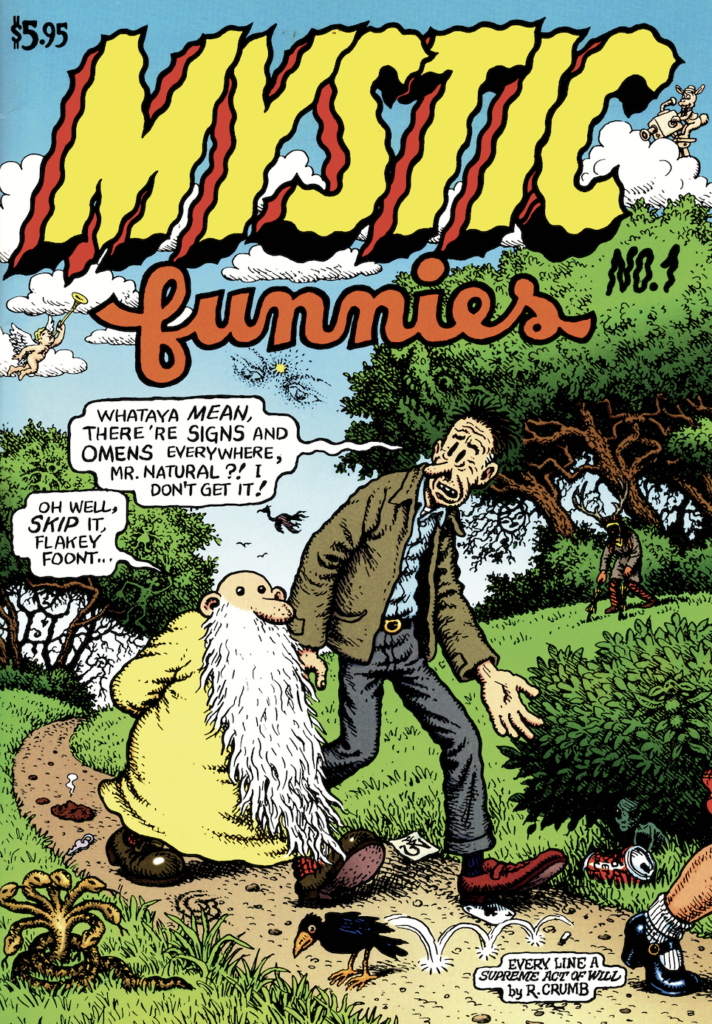A Troubled and Troubling Artist, Cartoonist Robert Crumb Is Subject of a Literary Biography
This isn’t the first time that his life and work have been the subject of sustained attention: Terry Zwigoff’s 1994 documentary ‘Crumb’ is among the finest cinematic portraits of an artist.

‘Crumb; A Cartoonist’s Life’
By Dan Nadel
Scribner, 480 Pages
“He grew into an outsider, took lessons in incredulity from the ethnic and racial outsiders he idolized, but was born inside the beast, nurtured on the bloody land, indoctrinated with its foundation sins.” Given the tenor of this prose, freighted as it is by the burdens of history, you might mistake it as an excerpt from a biography of Herman Melville or, perhaps, Ralph Ellison. But Dan Nadel is writing about another troubled, troubling, and quintessentially American figure, the cartoonist Robert Crumb.
Mr. Nadel’s soon-to-be-published book, “Crumb; A Cartoonist’s Life,” is the first literary biography of the man born in 1943 as Robert Dennis Crumb. This isn’t the first time that his life and work have been the subject of sustained attention: Terry Zwigoff’s 1994 documentary “Crumb” is among the finest cinematic portraits of an artist, an unexpurgated and often disturbing overview of one individual’s peccadilloes and the vagaries of his work.
In Mr. Zwigoff’s film, an art critic and historian, Robert Hughes, waxes majestic about Mr. Crumb: “He’s the Brueghel of the last half of the twentieth-century … because he gives you that tremendous kind of impaction of lusting, suffering, crazed humanity in all sorts of bizarre, gargoyle-like allegorical forms.” Some outré examples of Mr. Crumb’s cartoons flit by during Hughes’s commendation, in which he also ropes in as a point of reference a Spanish painter and graphic artist, Francesco Goya.
How Hughes missed Heironymous Bosch, Honore Daumier, or George Grosz I don’t know, but I suspect Mr. Crumb would’ve preferred a less highfalutin run of ancestors — vintage comic book cartoonists like “the Good Duck Artist,” Carl Barks, or Basil Wolverton, whose consummately hatched grotesqueries found their ways into places like “Lil Abner” and Mad Magazine. Mr. Nadel goes on to peg Mr. Crumb as “among the most profound and influential artists of the twentieth century.”

Dismiss that as a biographer’s hyperbole, but I daresay Mr. Nadel undersells the ripples that his subject put into motion. Only Andy Warhol — please, keep your Basquiats, Hirsts, and Banksys to yourself — has had as far-reaching an impact on the broader post-World War II culture. Warhol ultimately fell victim to the superficiality he sought to expose. The contradictions at the heart of the American soul fuel Mr. Crumb’s vision, a subject he continues to plumb to this day.
Mr. Crumb’s work — whether it’s the bopping avant-gardism of “Zap Comix No. 1,” the withering autobiographical meditations seen in the pages of “Weirdo,” or the densely limned narratives of “The Book of Genesis” — has not been to everyone’s liking. Critics have found Mr. Crumb’s comics to be, at best, self-indulgent and downcast. At worst, they’ve been deemed misogynistic, racist, and antisemitic.
A signature character like Angelfood McSpade begs the issue: What are we to make of a hypersexualized, perpetually bamboozled, and stereotypical tribal woman? The artist explains: She “stood for a purely abstract idea … my fault was in not realizing that people would take these cartoon images literally.”
The thin line that is sometimes trod between satirizing a subject and advocating for it was put into high relief in 1994 when a white-power periodical, Race & Reality, published without permission a Crumb comic about the takeover of America by Blacks, Jews, and “other scumbag elements.” The resulting controversy, according to the artist, “showed how far out in the twilight zone these paranoid characters are!”
Do we blame Mr. Crumb for a thundering level of naivete or, pace Mr. Nadel, commend his “well-observed warning about the racism and antisemitism embedded in America, masked as cathartic art”?
Catharsis is, if not Mr. Crumb’s primary leitmotif, then an ineradicable component of the drawings. Born to an autocratic father and a mother plagued by psychological maladies, the artist had an unhappy, peripatetic childhood. One of five children — not counting a daughter mother Bea had from a previous liaison — the fledgling cartoonist sought succor at the side of his older brother Charles, with their shared interest in comic books and, later, vintage blues and country music.
Upon graduating from high school, Mr. Crumb moved to Cleveland and began working for the American Greetings Corporation, where his preternatural gift for cartooning was encouraged — though his bosses did egg him on to make the drawings cuter. He later knocked around New York City, did illustrations for Topps bubble gum cards, and placed cartoons in a men’s magazine, Cavalier. Mr. Crumb married, had a son, and dropped LSD.
The latter had a profound effect on Mr. Crumb’s psyche and, by fiat, his imagery. The “squinky” comics that followed were improvisational, often hallucinatory, flagrantly sexual, impeccably crafted, angry, and outrageous. The work seemed part-and-parcel of the late 1960s — “Keep on Truckin’,” don’t you remember — and Mr. Crumb did benefit from the free-for-all hedonism of hippiedom. Yet his was always a more reactionary temperament, being less of a joiner than the most stubborn of iconoclasts. In retrospect, the confluence of Mr. Crumb’s vision and the Summer of Love appears both providential and a fluke.
Mr. Nadel wrote the biography with the artist’s participation, but not his final approval. As such, the author recounts, with impressive clarity, the complicated web of Mr. Crumb’s life: among its byways are his sundry amours, peculiar erotic tendencies, financial difficulties, marriage to fellow cartoonist Aline Kominsky, and an unenviable run of familial travails.
Mr. Crumb will likely bristle at the renewed attention generated by “Crumb; A Cartoonist’s Life” and shrug off any accolades bestowed upon him. The rest of us shouldn’t be so blithe. Mr. Nadel has written an excellent book about an inescapable figure.
Messrs. Crumb and Nadel will be speaking with a New Yorker cultural critic, Naomi Fry, at the 92nd Street Y on April 15.
Correction: Scribner is the publisher of “Crumb; A Cartoonist’s Life.” The publisher was incorrect in an earlier version.

